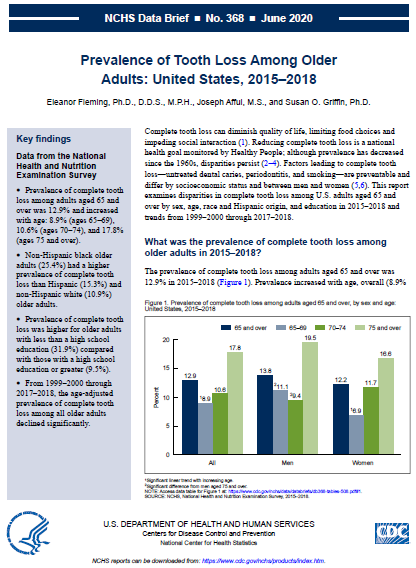Prevalence of Tooth Loss Among Older Adults: United States, 2015–2018
Posted on by Questions for Eleanor Fleming, Health Statistician and Lead Author of “Prevalence of Tooth Loss Among Older Adults: United States, 2015–2018.”
Questions for Eleanor Fleming, Health Statistician and Lead Author of “Prevalence of Tooth Loss Among Older Adults: United States, 2015–2018.”
Q: Why did you decide to do a report on tooth loss among older U.S. adults?
EF: Tooth loss among older U.S. adults is an important public health issue. Reducing complete tooth loss is a national health goal monitored by Healthy People. From a health perspective, tooth loss diminishes quality of life, impacts nutrition as food choices are limited, and can impede social interactions. Tooth loss is also preventable.
Q: Can you summarize how the data varied by sex, age, race and Hispanic origin, and education?
EF: While the prevalence of complete tooth loss has been diminishing since the 1960s, in other words, older adults are retaining their teeth; in 2015-2018, disparities continue to persist. Overall, the prevalence of complete tooth loss was 12.9%. We found differences in the prevalence of complete tooth loss by sex, age, race and Hispanic origin, and education.
The prevalence of complete tooth loss among adults aged 65 and over and increased with age: 8.9% (aged 65–69), 10.6% (70–74), and 17.8% (75 and over). There were also differences among women and men by age. Among women, prevalence increased in a similar pattern with age (6.9% for adults aged 65–69, 11.7% for 70–74, and 16.6% for 75 and over). There was a different pattern among men. Among men, complete tooth loss was higher in the oldest age group (19.5% for 75 and over) compared with the two younger groups (11.1% and 9.4%, respectively, for those aged 65–69 and 70–74). There were no observed significant differences in the prevalence between men and women.
By race and Hispanic origin, the prevalence of complete tooth loss is similar to patterns that we see in other oral health and health outcomes. There are differences among race and Hispanic and origin. Non-Hispanic black older adults (25.4%) had the highest prevalence of complete tooth loss compared with other race and Hispanic-origin groups. Among men, prevalence was also higher among non-Hispanic black men (23.4%) compared with non-Hispanic white (12.5%) and Hispanic (11.9%) men. Among women, prevalence of complete tooth loss was higher in non-Hispanic black women (26.8%) compared with Hispanic (17.8%) and non-Hispanic white (9.5%) women.
We also found differences in the prevalence of complete tooth loss among older adults by education level. We defined education in terms of less than a high education and a high school education or greater. Adults with less than a high school education had a higher prevalence of complete tooth loss (31.9%) compared with adults with a high school education of greater (9.5%).
Q: Was there a specific finding in the data that surprised you from this report?
EF: The statistical difference between Hispanic men and women was the most surprising finding in this report. It was not surprising that we observed the prevalence of complete tooth loss to be higher among Hispanic women (17.8%) compared to non-Hispanic women (9.5%). Nor, was it surprising that the prevalence of complete tooth loss among Hispanic men (11.9%) was lower compared to non-Hispanic white men (12.5%). However, a statistical difference Hispanic men and women was not expected.
When you look at the prevalence tooth loss by age among men and women, it is also striking that there were no statistical differences between men and women. While the pattern of estimates with age was difference, none of these differences were statistically different. One would hope to see either a similar pattern or statistical differences. Finding neither is striking.
Q: How did you obtain this data for this report?
EF: This report used National Health and Nutrition Examination Survey data, survey years 1999-2000 to 2017-2018. The survey includes an oral health examination, where dental examiners who are trained and licensed to practice in the United States conduct a tooth count. They assess whether a tooth is present or absence or all 32 teeth. We used these data to assess the absence of teeth in all teeth. Because the protocol for assess tooth count was similar in the survey years, we could combine the data. It should be noted, however, that protocols for the tooth count were similar, the dental examiners were not always dentists; licensed dental hygienists collected data for certain survey cycles.
Q: Is there any trend data that goes back further than 1999?
EF: This report includes trend data starting at 1999 with continuous data, meaning that survey has collected data continuously. While the oral health component has been part of the survey since its inception in 1959, we focused on these more recent, continuous data.
From 1999–2000 through 2017–2018, the age-adjusted prevalence of complete tooth loss decreased from 29.9% to 13.1%. The prevalence has decreased for both men and women.
Q: What is the take home message for this report?
EF: Overall, the prevalence of complete tooth loss among adults aged 65 and over was 12.9%, and the age-adjusted prevalence has decreased since 1999-2000. This is great news, as more older adults are retaining their teeth. However, for 12.9% of older adults to be without their teeth has tremendously public health importance and signals that additional work is needed.
Posted on by

